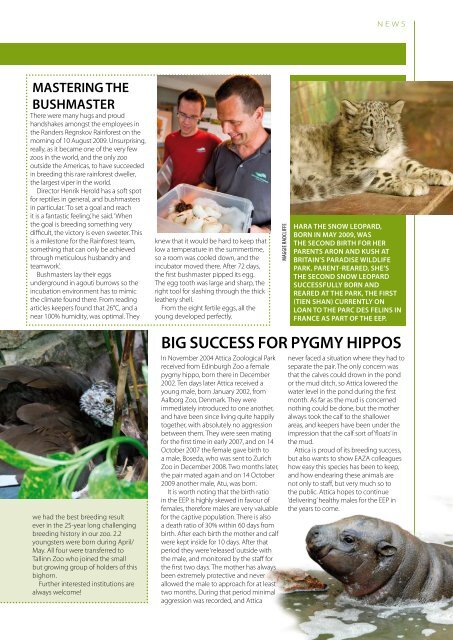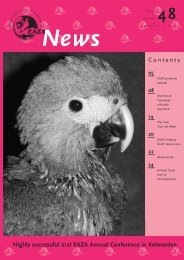Spring 2010 - European Association of Zoos and Aquaria
Spring 2010 - European Association of Zoos and Aquaria
Spring 2010 - European Association of Zoos and Aquaria
You also want an ePaper? Increase the reach of your titles
YUMPU automatically turns print PDFs into web optimized ePapers that Google loves.
mastering the<br />
bushmaster<br />
There were many hugs <strong>and</strong> proud<br />
h<strong>and</strong>shakes amongst the employees in<br />
the R<strong>and</strong>ers Regnskov Rainforest on the<br />
morning <strong>of</strong> 10 August 2009. Unsurprising,<br />
really, as it became one <strong>of</strong> the very few<br />
zoos in the world, <strong>and</strong> the only zoo<br />
outside the Americas, to have succeeded<br />
in breeding this rare rainforest dweller,<br />
the largest viper in the world.<br />
Director Henrik Herold has a s<strong>of</strong>t spot<br />
for reptiles in general, <strong>and</strong> bushmasters<br />
in particular. ‘To set a goal <strong>and</strong> reach<br />
it is a fantastic feeling,’ he said. ‘When<br />
the goal is breeding something very<br />
difficult, the victory is even sweeter. This<br />
is a milestone for the Rainforest team,<br />
something that can only be achieved<br />
through meticulous husb<strong>and</strong>ry <strong>and</strong><br />
teamwork’.<br />
Bushmasters lay their eggs<br />
underground in agouti burrows so the<br />
incubation environment has to mimic<br />
the climate found there. From reading<br />
articles keepers found that 26°C, <strong>and</strong> a<br />
near 100% humidity, was optimal. They<br />
we had the best breeding result<br />
ever in the 25-year long challenging<br />
breeding history in our zoo. 2.2<br />
youngsters were born during April/<br />
May. All four were transferred to<br />
Tallinn Zoo who joined the small<br />
but growing group <strong>of</strong> holders <strong>of</strong> this<br />
bighorn.<br />
Further interested institutions are<br />
always welcome!<br />
knew that it would be hard to keep that<br />
low a temperature in the summertime,<br />
so a room was cooled down, <strong>and</strong> the<br />
incubator moved there. After 72 days,<br />
the first bushmaster pipped its egg.<br />
The egg tooth was large <strong>and</strong> sharp, the<br />
right tool for slashing through the thick<br />
leathery shell.<br />
From the eight fertile eggs, all the<br />
young developed perfectly.<br />
In November 2004 Attica Zoological Park<br />
received from Edinburgh Zoo a female<br />
pygmy hippo, born there in December<br />
2002. Ten days later Attica received a<br />
young male, born January 2002, from<br />
Aalborg Zoo, Denmark. They were<br />
immediately introduced to one another,<br />
<strong>and</strong> have been since living quite happily<br />
together, with absolutely no aggression<br />
between them. They were seen mating<br />
for the first time in early 2007, <strong>and</strong> on 14<br />
October 2007 the female gave birth to<br />
a male, Boseda, who was sent to Zurich<br />
Zoo in December 2008. Two months later,<br />
the pair mated again <strong>and</strong> on 14 October<br />
2009 another male, Atu, was born.<br />
It is worth noting that the birth ratio<br />
in the EEP is highly skewed in favour <strong>of</strong><br />
females, therefore males are very valuable<br />
for the captive population. There is also<br />
a death ratio <strong>of</strong> 30% within 60 days from<br />
birth. After each birth the mother <strong>and</strong> calf<br />
were kept inside for 10 days. After that<br />
period they were ‘released’ outside with<br />
the male, <strong>and</strong> monitored by the staff for<br />
the first two days. The mother has always<br />
been extremely protective <strong>and</strong> never<br />
allowed the male to approach for at least<br />
two months. During that period minimal<br />
aggression was recorded, <strong>and</strong> Attica<br />
maggie radcliffe<br />
NEWS<br />
hara the snow LeoPard,<br />
born in may 2009, was<br />
the second birth For her<br />
Parents aron <strong>and</strong> Kush at<br />
britain’s Paradise wiLdLiFe<br />
ParK. Parent-reared, she’s<br />
the second snow LeoPard<br />
successFuLLy born <strong>and</strong><br />
reared at the ParK, the First<br />
(tien shan) currentLy on<br />
Loan to the Parc des FeLins in<br />
France as Part oF the eeP.<br />
big success For Pygmy hiPPos<br />
never faced a situation where they had to<br />
separate the pair. The only concern was<br />
that the calves could drown in the pond<br />
or the mud ditch, so Attica lowered the<br />
water level in the pond during the first<br />
month. As far as the mud is concerned<br />
nothing could be done, but the mother<br />
always took the calf to the shallower<br />
areas, <strong>and</strong> keepers have been under the<br />
impression that the calf sort <strong>of</strong> ‘floats’ in<br />
the mud.<br />
Attica is proud <strong>of</strong> its breeding success,<br />
but also wants to show EAZA colleagues<br />
how easy this species has been to keep,<br />
<strong>and</strong> how endearing these animals are<br />
not only to staff, but very much so to<br />
the public. Attica hopes to continue<br />
‘delivering’ healthy males for the EEP in<br />
the years to come.

















